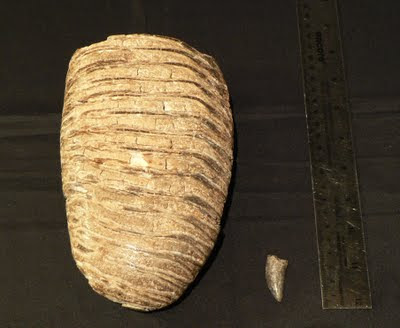Take a look at the picture below and take a guess as to which is a dinosaur tooth and which is a mammoth tooth.
The small, partial tooth is from an Albertosaurus, a meat-eater that looked a lot like a Tyrannosaurus rex, just a bit smaller and lived during the cretaceous period. Albertosaurus was about 8-9 metres long, 3 metres tall at the hip and weighed up to 3 tonnes. It had short arms with two-fingered hands and long powerful back legs with three-toed feet for speed and agility. The “Alberta Lizard” was first discovered in 1884 by J.B. Tyrrell along the Red Deer River in Alberta.
This Albertosaurus tooth may look small but it would have been razor-sharp 75 million years ago, perfect for tearing flesh.
Contrary to the “Alberta Lizard”, the mammoth was a grazing plant-eater that fed mostly on grasses. They were ancestors to but larger than the modern Asian elephant. They lived during the Pleistocene era, also known as the American Ice Age and died out at the end of the Ice Age, about 10,000 years ago. They were about 5 metres long, up to 4 metres tall at the shoulder and weighed up to 3 tonnes. Their pointed, curved tusks could be up to 5 metres long, though they usually ranged from 3-3.7metres long.
With how large the mammoths were, they would have spent up to 20 hours a day grazing for food. In that case, it’s fortunate that the mammoths teeth were composed of layers of compressed enamel plates, held together with cementum. This composition made them very strong and resistant to wear, since eating grass is a hard thing to do and really wears at the teeth.
Come and join us to learn more about palaeontology, the study of fossils from past ages, on Thursday, June 16th, 2011. Robin Sissons and Katalin Ormay, palaeontologists from Grande Prairie Regional College will be with us at Athabasca Hall from 12 noon – 1 PM and 3 – 6 PM for public drop in sessions and again at 7:30 PM for a public presentation on Northwest Alberta Palaeontology.









